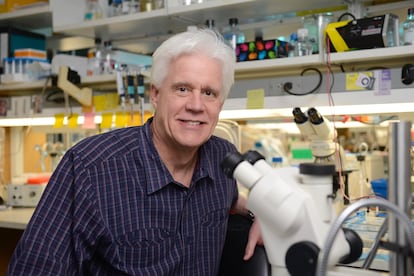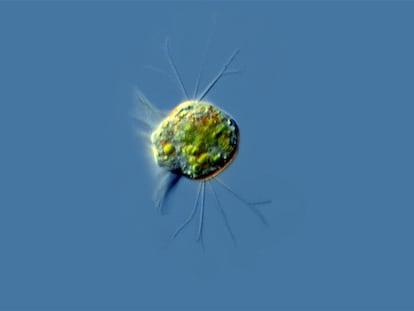Scientists create genetic ‘pen’ that corrects common heart conditions
The sophisticated experimental treatment, which has proven to be effective in mice, opens the door to therapies that would be applied once and last a lifetime

The gene editing techniques that have revolutionized medicine since 2016 could also be used to treat common heart diseases, the number one cause of death in humans, according to a study published recently by one of the world’s leading scientists, Eric Olson, from the US. His team was able to modify two letters – or bases – of the approximately 3 billion that make up the DNA of a mouse. This change was enough to silence a protein linked to multiple cardiovascular problems. Olson is cautious, but highlights the potential advantages of this new strategy: since heart cells last a lifetime, it is only a matter of making the change once.
DNA is like a recipe book for making proteins, the minuscule machines that take care of the main tasks in a living being: carrying oxygen through the blood, fighting viruses, digesting food. That manual is written with four letters, repeated millions of times: ATGGCGAGTTGC… each of these letters is the initial of a chemical compound with different amounts of carbon, hydrogen, nitrogen and oxygen: adenine (C₅H₅N₅), cytosine (C₄H₅N₃O), guanine (C₅H₅N₅O) and thymine (C₅H₆N₂O₂). Olson’s group used “a fine-tipped pen” to change an A to a G a couple of times; now the recipe is no longer the same.
The history of this ultra-precise pen dates back to 2003, when the Spanish scientist Francis Mojica discovered by chance that some microbes from the Santa Pola salt flats in Alicante, Spain, used molecular scissors to identify invading viruses and cut their genetic material. Mojica, from the University of Alicante, named this mechanism CRISPR. Then, in 2012, French biochemist Emmanuelle Charpentier and American chemist Jennifer Doudna noticed that these microbial scissors could be used to modify the DNA of any living being, a discovery that earned them the Nobel Prize in Chemistry. Now, Eric Olson’s team has used one of the most accurate versions of these CRISPR tools: the so-called base editors, invented in 2016 by American David Liu, a chemist from Harvard University who is considered one of the geniuses of modern science.
Liu himself applauds the new experiment, deeming it a clever use of base editors that brings up the possibility of not only treating certain types of heart disease, but also preventing their development, either spontaneously or after injury. Until now, the first rudimentary CRISPR techniques had focused on trying to correct specific mutations that cause rare diseases; the new study helps broaden the therapeutic applications of base editors beyond just treating a single gene mutation. Details of the experiment were published in the journal Science.
Eric Olson, from the University of Texas Southwestern Medical Center, talked about his research to EL PAÍS via videoconference from Dallas, Texas, accompanied by a Spanish colleague from his laboratory, biologist Xurde Menéndez Caravia, co-author of the new study, who explained that the results of the first proof of concept are very promising. The technique appears to be safe in mice; now, what comes next is to explore the possible long-term effects.
The researchers modified the recipe for a protein called CaMKII delta, whose hyperactivation causes various cardiovascular problems such as arrhythmias, heart failure or damage to the heart muscle after a myocardial infarction. By changing two letters in the recipe, the resulting protein is not hyperactivated. Olson’s team used this technique in mice with cardiac damage after a heart attack, a phenomenon known as ischemia-reperfusion injury. The organs of the rodents recovered their function after the genetic editing of their cells. “As a therapy aimed at large population groups, it would be a revolution. We are talking about myocardial infarctions: potentially millions of people could be treated with this technique,” says Menéndez Caravia.

The American company Verve Therapeutics already uses a similar strategy to deactivate a gene that is associated with high levels of bad cholesterol. After obtaining promising results in monkeys, the company began a clinical trial with people in July. The difference, explains Olson, is that Verve Therapeutics uses base editors to completely turn off a gene, while his team uses them to subtly correct its function. David Liu himself founded a company, Beam Therapeutics, which began a trial with base editors in November in patients with sickle cell anemia, an inherited disorder of the red blood cells.
Olson is aware of the limitations of his study. “Does it work in animals besides a mouse? We haven’t tested it, of course, in a primate, and certainly not in a human. So we would need to ensure that it is effective and safe. And also, I think the long term effects of this therapy would need to be examined, because once it’s corrected, it’s forever,” acknowledges the scientist.
To geneticist Lluís Montoliu, from the National Center for Biotechnology in Spain, database editors are an astonishing feat. “It is a great idea that David Liu had in 2016 and, in just six years, we are already talking about applications in animals and even in people,” he celebrates. Montoliu points out that base editors recently saved the life of Alyssa, a British girl who suffered from very aggressive leukemia and was treated with donor white blood cells that were modified with the revolutionary fine-tipped pen.
David Liu’s laboratory is constantly improving its base editors and regularly coming up with new, more accurate versions, to the point where geneticists around the world can hardly keep up, says Montoliu. The Spanish researcher, however, emphasizes that the technique is still not perfect and can produce some unwanted letter changes; this occurred in Eric Olson’s mice, although apparently without adverse effects.
Cardiologist Javier Limeres is also very cautious. In his hospital, the Vall d’Hebron in Barcelona, Spain, they have studied molecules that were able to reduce cardiac damage due to ischemia and reperfusion in mice and even in pigs. “There were very positive data, but when these molecules were tested in humans, the results were not the same,” explains Limeres, president of the area of Familial Heart Disease and Cardiovascular Genetics of the Spanish Society of Cardiology. The doctor, however, also admits his enthusiasm: “Gene editing opens up a very wide spectrum of possibilities. I think it is the third revolution in medicine, after surgery and drugs.”
Sign up for our weekly newsletter to get more English-language news coverage from EL PAÍS USA Edition
Tu suscripción se está usando en otro dispositivo
¿Quieres añadir otro usuario a tu suscripción?
Si continúas leyendo en este dispositivo, no se podrá leer en el otro.
FlechaTu suscripción se está usando en otro dispositivo y solo puedes acceder a EL PAÍS desde un dispositivo a la vez.
Si quieres compartir tu cuenta, cambia tu suscripción a la modalidad Premium, así podrás añadir otro usuario. Cada uno accederá con su propia cuenta de email, lo que os permitirá personalizar vuestra experiencia en EL PAÍS.
¿Tienes una suscripción de empresa? Accede aquí para contratar más cuentas.
En el caso de no saber quién está usando tu cuenta, te recomendamos cambiar tu contraseña aquí.
Si decides continuar compartiendo tu cuenta, este mensaje se mostrará en tu dispositivo y en el de la otra persona que está usando tu cuenta de forma indefinida, afectando a tu experiencia de lectura. Puedes consultar aquí los términos y condiciones de la suscripción digital.











































